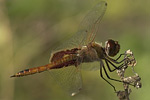
 Dragonflies & Damselflies of Curacao Mars Muusse - the Netherlands
Dragonflies & Damselflies of Curacao Mars Muusse - the Netherlands
Red Saddlebag (Tramea onusta).
The Saddlebag dragonflies have a diagnostic habit in flying with the abdomen held downwards, hanging. The obvious maculated patches in the wing (from which they get their names) are accentuated when doing so.
There are a few red species known to occur around the Caribbean, and three of them were recorded on Curacao in March 2009. The fourth recorded for the region, T. insularis, has not been recorded and is found in the West Indies.
Red Saddlebag is one of these red species that is widely distributed across the region. Its face is pale brown initially but turns red in mature males. The thorax is brown and unmarked. The wings have reddish-brown veins anteriorly and the hindwing have a large basal brown crossband that doesn't generally extend beyond the midrib of the anal loop. Generally there is a large central clear spot in this crossband. The legs are pale turning black more distally. The abdomen is yellowish-brown in females, but turns red in mature males. Segments 8-10 are black dorsally and pale laterally.
On Curacao, they are pretty easy to photograph as they often perch at 'Wabi' twigs (Acacia's) and they are abundant all over the island. Very often, they fly in mixed flocks with T. abdominalis and T. calverti, making exact estimations difficult, but March 2009 several locations held 100's of Tramea's. This species is seen at temporary and permanent ponds, but also gardens, drier Acacia vegetation, parking lots near beaches at the south, the sheltered side of Christoffel Hill, in the north at Shete Boca and the vast Acacia field in the north (the 'mundi') and east of the island (southeast of Playa Canoa).

Red Saddlebag (Tramea onusta). Muizenberg - Curacao, March 2009. Female.

